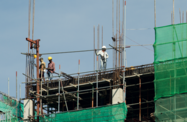
 On boosting the local production of materials
On boosting the local production of materials
How will the pandemic impact local steel production over the longer term?
SEBASTIAN LANGENDORF: Before the Covid-19 pandemic, 5% of the 2.5m tonnes of steel consumed in Myanmar each year was locally produced. We expect two major trends to arise after Covid-19. The first is stronger regional and domestic supply chains. Steel has a long value chain and had already faced some supply disruptions due to international trade disputes. There is now recognition – catalysed by the pandemic – that the stability of supply is as important as cost. This increases the appeal of regional supply chains and, I think in Myanmar, this will also lead to greater domestic sourcing.
The second trend we anticipate is macroeconomic: a weaker US dollar, following Covid-19 response measures implemented by the US Federal Reserve, could lead to inflated dollar costs for commodities sourced in countries with a stronger currency. These two trends combined could make Myanmar a more attractive destination for industrial relocation within the steel industry.
Which measures could the government take to support local content in the steel industry?
LANGENDORF: Myanmar requires action to ensure that the necessary basic infrastructure is in place to enable stable production – primarily electricity, followed by port infrastructure and inland transport. Moreover, the industry requires regulations with transparent rules and investment incentives to create a level playing field: it is difficult for producers in Myanmar to compete with those in countries such as China that have a well-established supply chain, and an advantage in terms of time and cost.
As a sign that mechanisms are being introduced to enhance the competitiveness of the domestic industry, a framework for import restrictions is due to be effective in Myanmar from July 2021 – although questions remain around the application of the law, including the industries that it will affect.
Incentives, including commercial tax relief, could also encourage the consumption of locally produced building materials and promote the growth of domestic companies.
In what ways can special economic zones (SEZs) facilitate the manufacture of building materials?
LANGENDORF: SEZs can help reduce waiting times and logistical costs. These zones often have strategies to maintain high standards, leading to a higher quality of products, even if they are perhaps more expensive to make. While some SEZs focus on cost, it is beneficial for emerging economies such as Myanmar to focus on quality, sustainability and transparency, in line with international standards, as is the case in the Thilawa SEZ.
Secure and reliable infrastructure for public services such as electricity, transport and water is also key for the production of construction materials. In this regard, SEZs such as Thilawa play an important role, as these zones have an ecosystem that offers the crucial facilities required by factories. Thilawa features a stable electricity supply from an established power plant, integrated transport infrastructure with roads and a port to trade raw materials and finished products, easy access to water and a drainage system. These facilities – along with an adherence to international standards and clear, transparent regulations – serve as a model to be extrapolated throughout the country.
To what extent can modern technologies help to raise building quality and standards in Myanmar?
LANGENDORF: Generally, more durable and higher-quality building materials are the direct result of using more advanced machinery and technology during production. It is a company’s responsibility to raise awareness of this fact by showing customers how new technology can extend the lifespan of products. While it is true that high-quality building materials are more expensive at the time of purchase, if you look at their cost per year of life, materials of higher quality are actually cheaper in the long run. Some countries such as Singapore have a challenging meteorological climate, and they use high-quality building materials to help minimise the impact of this. Myanmar has long rainy seasons, high heat and a lot of dust. Using higher-quality building materials will have a notably positive impact on both an individual and a national level by minimising the ramifications of the climate.
In terms of creating guidelines, the Myanmar Iron and Steel Association is developing a wide range of standards that establish a number of benchmark references for quality. Other types of building materials, as well as other industries and economic sectors must similarly follow suit to enable them to reap a host of benefits, including safer and higher-quality products, and more competitive products for export.


 On boosting the local production of materials
On boosting the local production of materials